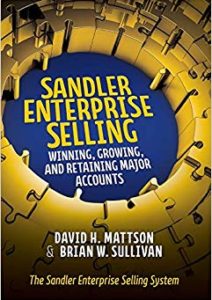We’re all aware of the unique challenges faced by sales teams in complex enterprise account pursuits. As opposed to opportunities with smaller accounts, enterprise deals present much more frustrating pains and complexities to selling organizations. Long sales cycles, wide buyer networks, and highly capable competitors are just a few of the obstacles that must be faced and overcome. Pursuing enterprise business is not for the faint of heart. It demands that you bring your very best effort and then execute with precision to walk away with a win.
But just being involved in an enterprise pursuit brings a hefty price of admission as evidence in a chat I had with the president of a Texas firm that sells to and serves major accounts. In discussing how Sandler Enterprise Selling would increase her organization’s effectiveness in winning major account business, she shared that “Whenever we decide to pursue a large opportunity, it costs us $30,000. Win or lose, we’re on the hook for $30,000!”. She added, “What’s most difficult for us is identifying the deals we’re most likely to win and then knowing whether to push on or to call it off. Knowing which deals to go after and whether to stay or go – that’s what drives us crazy and costs us big money”.
Of course, she makes a significant point regarding the financial costs of pursuing an enterprise opportunity. That’s a painful issue very familiar to all of us involved in enterprise selling. And if your price of admission for major account pursuits is similar to $30,000, less or as in many cases, much more, the numbers always scale. But there’s a lot more involved in paying to play than simply the financial commitment. For credibly pursuing large deals involves people – your scarce resources whose time is precious. Think about it. How many organizations have employees who aren’t busy, people who are unsubscribed and available to be applied to major account pursuits? While such surpluses of people may have been more common in the days before rightsizing and layoffs, it’s simply unheard of today. And when already-busy people are attached to and engaged in a lengthy enterprise pursuit, they are typically unavailable for a lot of their normal workload. As a result, other initiatives are delayed or shelved altogether. And very often, when pursuing a potentially game-changing enterprise deal, selling organizations engage their best and brightest people to increase the chances of winning, thus exacerbating the negative impact of the stifling opportunity costs. This is an issue, of course, even if you ultimately win the big deal that occupied so much of your best people’s time. But imagine how crippling the opportunity costs are when you lose. It’s clear to see why our Texas friend is so focused on making the right bets about which deals to pursue and invest in.
It gets worse. Consider your organization’s overall energy. How many of these all-encompassing enterprise deals can be credibly pursued at one time? While the prospect of winning multiple game-changing contracts can be incredibly tempting, you must be realistic about your capabilities and your resources. For if you make the decision to water down your efforts on one enterprise pursuit to fortify another, you are simply diminishing your chances of winning either one. And for each of the opportunities, you pursue with less than your best effort, there’s certain to be one of those worthy, sophisticated competitors involved. And they’ll be all-in, laser-focused on their pursuit, ready to overwhelm your weakened initiatives.
Of course, the significant financial investment involved in paying to play in enterprise pursuits is greatly magnified by these other types of organizational expenses. And your true cost of sale must take them into account. For these frequently ignored and seemingly less direct outlays are often the most painful. Given this minefield of cost, you simply must build and follow a profile framework to realistically identify the deals that provide you with the highest probability of success. This basic organizational competence identifies the attributes of the deals that map best to you and guides your sales team to understand and target the true profile deals, those most tightly aligned to your strengths. This fundamental principle must be baked into your organization’s selling DNA as part of your instinctive selling mindset. For identifying profile deals is not a static activity occurring at a snapshot in time. It’s a mindset guiding all communications with accounts. Not just in evaluating opportunities. And not just after you receive an RFP.
So, bring your profile framework to life, making it a dynamic competitive advantage in your selling process. It will guide you to the deals where the likelihood of successful delivery, healthy margins, and robust client satisfaction is greatest. And to the deals, you are most likely to win.












Comments